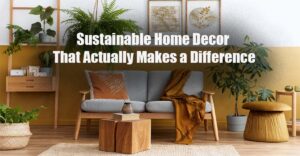Let’s face it—ideally, your house should be a refuge instead of a source of guilt. Nothing but the most splendid fact, though, stylish living space and a green planet are no longer opposites. You are now in the area of sustainable home decor where the planet-conscious choice has a story worth sharing.
What I recollect as the least moment of my life was when I finally realised how much the choice of our sustainable home accessories affects the whole situation. While in the very first place in the furniture store and getting lost among the many options, suddenly I noticed the “new furniture smell” and immediately recognised it as the one that makes one feel nearly like licking a bottle of chemicals. At that time, I retrogressed to one more stage of making my sustainable home furnishings less and less so, no doubt? It’s been a very rewarding journey in my life.
Why Sustainable Home Decor Isn’t Just a Trend (It’s Your Home’s Future)
What may astonish you is that the huge amount of deforestation, pollution, and waste that the furniture and home goods industry produces is all under their name. The total amount of furniture that goes to landfills yearly is in millions of tonnes. However, do not start piquing the feeling of despair; just take a deep breath. This is because you are going to hear the other side of this tale, and it is nothing short of being very empowering.
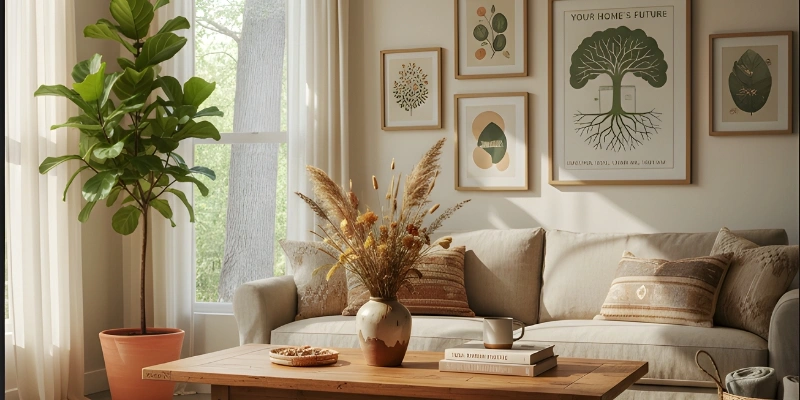
By picking eco-friendly home decor, you not only make a good choice, but you also start a whole chain reaction. You are making the lives of the craftsmen who put their souls into creating their works easier. You are making it possible for trees that have lived for hundreds of years to remain standing. You are preventing the inhalation of poisonous chemicals by keeping them out of your living space. And also, you are doing all that while creating a home that is, in no small measure, your own and, indeed, true to your character.
The magnificence of green home decor is that it does not matter whether you are perfect or not; what is important is that you are making progress. Every sustainable home decor choice you make, regardless of its size, is a step that brings you closer to being a part of the movement advocating for conscious living. And what is even better? The places you create would feel more personal, more meaningful, and, to tell you the truth, more beautiful than anything you could get from a generic showroom floor just because the choices are yours.
The Building Blocks: Understanding Sustainable Home Decor Materials That Matter
Let’s get straight to the core of what makes sustainable home goods really sustainable. Not at all, just a case of marketing waffling—knowing the materials is exactly like mastering a new language; after you have acquired it, you will never do your shopping the same way.
Bamboo is the superstar of eco-friendly materials, and it has been so for a long time. It is not merely a wood substitute; bamboo is actually a plant that is a grass and grows quicker than the grass of your neighbour. When made into furniture, it gives this amazing blend of stiffness and softness.
Let’s now shift focus to reclaimed wood—my number one choice when it comes to sustainable home accessories that have a story to tell. Every item made from reclaimed wood is unique due to its grain, nail holes, and weathered surface. You won’t just purchase a piece of furniture; you will be a keeper of tales.
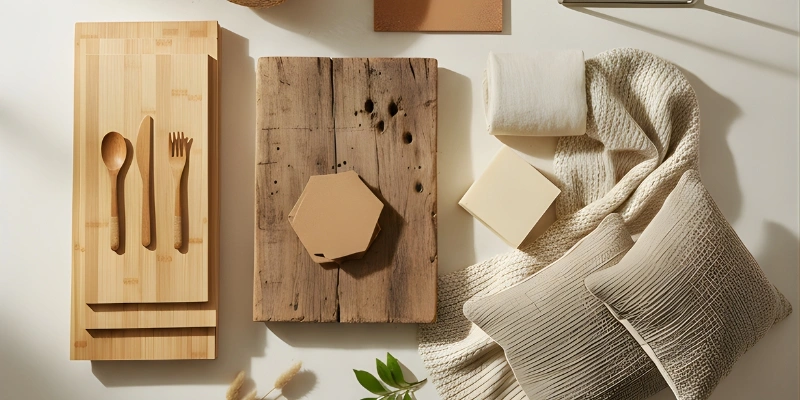
Fabrics made of organic cotton and hemp are the unsung heroes in the area of sustainable home furnishings. Traditional cotton farming is ridiculously resource-draining, which means very high water and pesticide usage. On the contrary, organic cotton is thrifty in the input and luxurious in the output, so to speak. If you use organic cotton upholstery or hemp cushions, then you are choosing fabrics that are ventilated, longer-lasting, and do not off-gas harmful chemicals into your dwelling.
Natural latex is a great tree that needs to be introduced to more people as the sustainable furniture revolution. The foam coming from the sap of the rubber tree is the opposite of the petroleum-based foam in that it is a product that doesn’t emit volatile organic compounds. The rubber tree is not killed during the sap extraction process; instead, it just gets the sap harvested, and it grows back, which means it is an infinitely renewable resource.
Cork is the timber of the future and the past at the same time, and its range of application is beyond wine bottles. The cork oak trees, whose bark is the source of this wonderful material, are completely and literally stripped of bark every nine years. In modern day, the cork flooring is being replaced by chic coasters and even gorgeous wall panels made from cork, which is a winner in not just being eco-friendly but also stylish for modern sustainable room decor.
Let’s speak about the recycled materials openly. It might look strange to use recycled plastic, which is not the same thing as being eco-friendly after all, but allow me to clarify. In a sense, every piece of plastic furniture made from recycled material is a piece of plastic waste that has not ended up in the ocean or landfill. Usage of recycled metal adds to the sustainability of the home. accessories, and at the same time, it gives a huge reduction in the environmental impact of metal mining and processing.
Bringing Nature Home: The Magic of Biophilic Design
When you first encounter the idea of biophilic design, get ready to get hooked on a concept that has been scientifically established to make you happier, healthier, and more productive. The main principle is not just about putting a plant on your windowsill (although this is certainly a good beginning). It is about constructing environments that truly filter the outdoors into the indoors and vice versa.
Indoor plants are indeed the most common and the most accessible way to experience biophilic design, and they come with a lot of good reasons. You can choose to go for a stunning palm tree in the corner of your living room or have a vibrant living wall that serves as the focal point of your space. Plants are the ones that literally bring life to sustainable home decor.
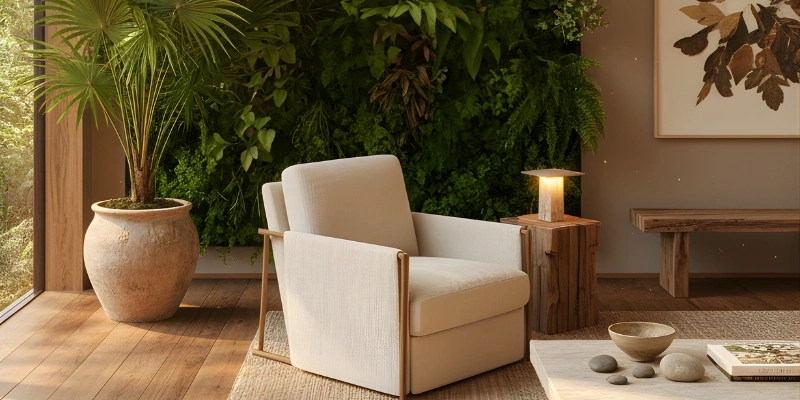
The natural light is the one that takes the top glory in the eco-friendly home decor. Making the most of daylight not only cuts your energy costs but also helps your body tune its clock, uplifts your spirits, and makes the rooms feel four times bigger. When daylight becomes insufficient, using energy-saving lighting such as LED bulbs or solar-powered fixtures that continue the sustainable theme into the evening is a wise choice.
Natural elements such as stone, clay, and wood not only ensure that the aesthetic is eco-friendly, but they also introduce a variety of textures, and these textures are very hard to match with their synthetic counterparts. Materials like these have been the preferred choice in the production of sustainable home furnishings even during ancient times, as they have proven to be effective. One of the advantages of using natural stone or unrefined wood is that every piece is truly a one-and-only, hence having the organic uniqueness that mass-produced items can never offer.
The Art of Choosing Sustainable Home Furnishings That Last
A sustainable home goods option that is easy and effective at the same time is buying less but buying better. This principle totally turns around the conventional consumer culture. Instead of cluttering your home with cheerful items that might lose their charm in a month, go for a piece of furniture that is classic and has been made skilfully from quality, sustainable materials that will only get better with time.
FSC-certified wood is the ultimate power of choice when choosing your wooden furniture. The abbreviation for the Forest Stewardship Council certification indicates that the wood is sourced from eco-friendly forests where not only are trees cut down but also replanted, and wildlife shelters are safeguarded, besides being beneficial to the local society.
Modular furniture is a sign of the future of eco-friendly home goods, and it is a smart choice because of its transparency. Modular design enables you to adapt, fix, and rearrange your furniture according to your changing needs.
The informal but highly effective use of space-reducing and multifunctional furniture has to be emphasised strongly, particularly when you are living in a small apartment or studio. A coffee table that can be turned into a dining table, a sofa bed that does not give away its identity as a sofa bed, and storage ottomans doubling as extra seating – these innovative products not only increase the space and therefore the life of the product but also eco-friendliness.
The Low-VOC Revolution: Breathing Easy in Your Sustainable Space
One thing that is hardly ever put on the table is an issue related to the “new furniture smell”. The latter, I already mentioned, is made up of volatile organic compounds (VOCs) that are slowly but surely disappearing into your home. Such substances include formaldehyde and benzene, which might provoke headaches or respiratory problems among some people. In this light, the non-toxic and low-VOC furniture becomes a very valid necessity.
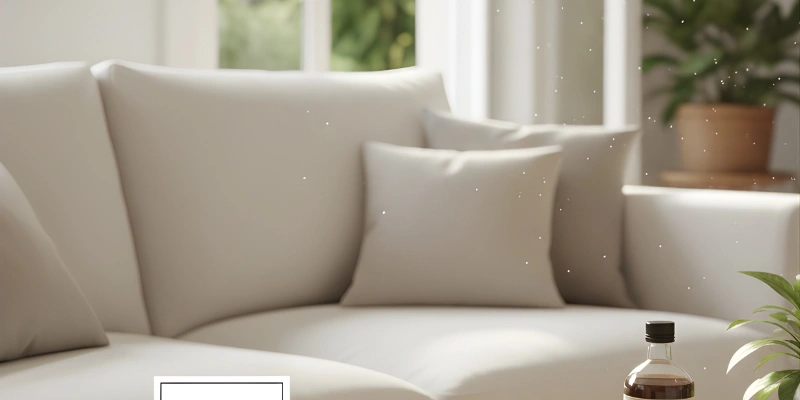
The foam that is certified by CertiPUR-US is an essential change over the standard furniture foam and a significant step for the whole industry. The use of CertiPUR-US customs as a stamp for the eco-friendly made-to-order upholstered furniture becomes so simple that you can always be sure that the quality of the indoor air is not affected in any way by poisons.
It is actually a good thing that natural wood finishes have finally made it to being very popular. Instead of treating the furniture with synthetic varnishes that release large quantities of VOCs, one can find items that have been finished with natural products such as beeswax, linseed oil, and carnauba wax or with plant-based stains. The latter are not only environmentally friendly but also aesthetically pleasing—their ability to preserve the wood’s natural look while keeping it breathable and allowing for gradual aging is remarkable.
Zero-Waste Decor: Getting Creative with What Already Exists
The most sustainable piece of furniture is often the one that already exists—either in your home or someone else’s. With some eco-friendly paint and new hardware, it becomes a stunning statement piece that carries both history and personality.
Thrift stores and antique shops are treasure troves for sustainable home decor enthusiasts. Every vintage find is a piece that doesn’t require new manufacturing, new shipping, or new resource extraction. Plus, older furniture was often built with better materials and craftsmanship than much of today’s fast furniture
The beauty of repurposed materials lies in their unexpected transformations. Old wine barrels become bathroom sinks. Shipping pallets turn into coffee tables. Vintage windows, frames, mirrors, or artwork. This approach to sustainable room decor brings genuine originality to your space—nobody else will have what you have.
Color and Texture: The Sustainable Palette
Sustainable home decor is currently being ruled by earthy shades and warm neutrals, and logically so. Colors such as terracotta, deep greens, ochre, taupe, and rich browns are all the shades of natural landscapes and thus contribute to grounding and calming the places they are used in.
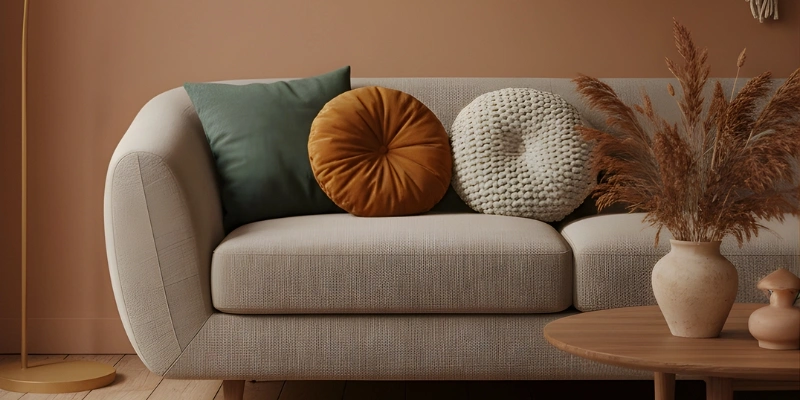
The use of organic shapes and curvilinear furniture adds a warm quality to the space that the rectangular minimalism sometimes lacks. Round mirrors, arching doorways, sculptural lighting, plus flowing textiles—these are the elements that add visual interest, and at the same time, the crucial connection to nature is kept.
For textiles, the texture trinity of linen, wool, and cotton is the most dominant in sustainable home accessories. Linen is very breathable and gets even softer over time. Wool, on the other hand, is inherently fire-resistant, temperature-controlling, and astonishingly long-lasting. Organic cotton provides that well-known comfort without causing a catastrophe for the earth.
The Artisan Advantage: Supporting Handcrafted Sustainable Home Accessories
Having handcrafted decor that reflects the maker’s craftsmanship in every detail is very gratifying. The ceramic vase that has a minor defect, the marks of the tool on a wooden bowl that has been carved, the small changes in the woven textiles—all these “imperfections” are indeed proofs of authenticity.
When you support local artisans, you are not only helping yourself but also the environment and the community, and the economy of the area. You reduce the people’s salaries who have been working in the factory, preserving traditional crafts, reinforcing local economies, and causing a drastic reduction in the amount of transportation emissions. Moreover, the partnership with the manufacturers usually allows you to change the designs so they would exactly serve your space and style.
Energy Efficiency: The Invisible Sustainable Home Decor
While LED lighting may not seem like the obvious choice for sustainable home decor, when you choose the right lighting, it can transform the very feel of that space as well as the impact on the environment. Currently, LED bulbs consume approximately 25% of the energy of incandescent bulbs but are rated for up to 25 times the life. This is a huge gain, as you won’t even have to think about the colour temperature anymore because you can alter the mood; it’s just light and imagination without the energy waste.
Smart home technology is a natural counterpart to sustainability in home decor. Programmable thermostats, automated blinds, and smart lighting systems are just a few of the smart home technologies that will help you use less energy, usually without you even noticing it.
Minimalist Maximalism: Finding Your Sustainable Balance
Minimalism in its greatest form expresses the idea of intentional living. Having a smaller number of quality things that serve several purposes and give real happiness. It is the combination of Marie Kondo’s teachings and the awareness of environmental issues. Each item in your area must justify its existence through beauty, usefulness, or both.
On the other hand, maximalism is characterised by plenitude; nevertheless, sustainable maximalism is the same as curated plenitude. It consists of vintage collections, artisan textiles, repurposed treasures, and handmade sustainable home accessories that are carefully placed with intention.
What is the main difference? Each item has a history, a function, and quite possibly a second (or third) life already lived. Bold patterns, deep hues, and different textures deliver a visual treat that is also eco-friendly.
Making It Real: Your Sustainable Home Decor Action Plan
Start small, but start talking. You are not obligated to throw away all the items in your house today and replace them with new ones. It is often the most environmentally friendly choice to keep using what is already in the house. But you’re adding or replacing items, so make smart decisions. For these highly used items, pick organic textiles, natural latex cushions, and low-VOC materials.
Investigate certifications before buying. Search for FSC-certified wood, GOTS-certified organic textiles, OEKO-TEX fabric certification, CertiPUR-US foam, and GREENGUARD indoor air quality approval. These are not merely stickers—they are third-party verified guarantees that products comply with strict environmental and health standards.
Spend money on antiques that will last forever. The timeless design is sustainable since it doesn’t become outdated. The classic linen sofa, the beautiful solid wood dining table, and the hand-woven jute rug are the basics of the sustainable home decor that adapts to your lifestyle rather than requiring a total makeover every few years.
The Future Is Already Here
The thrilling news? Sustainable home decor has gained really good acceptance, and it looks like it is here to stay. There is no need to search through very hard-to-find websites or pay very high prices already (but it is always nice to support smaller, eco-friendly brands). Well-known retailers have introduced sustainable home goods, bamboo furniture, organic bedding, and recycled material pieces at price levels that almost everybody can afford.
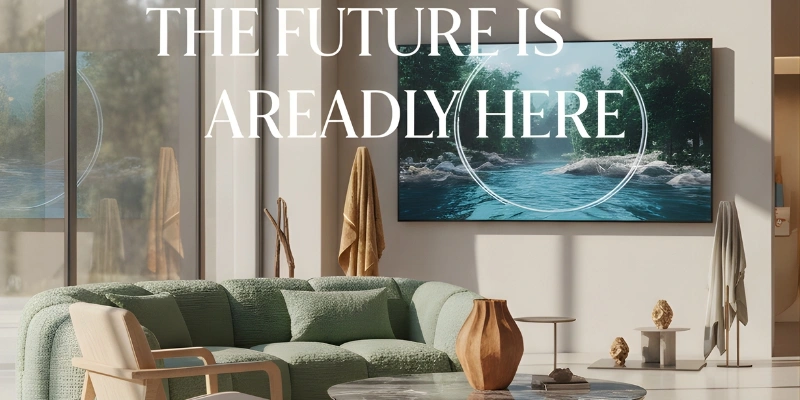
The innovations do not stop there; they keep on pushing the limits by using the new technologies. Bio-based materials such as mushroom leather and algae fabric are gradually moving from being experimental to commercial. Plant-based resins are doing the job of replacing petroleum plastics. Mycelium panels provide insulation and structure at the same time. These modern materials are showing that sustainability and innovation are not opposites but rather partners who are creating a nicer future.
Your Home, Your Values, Your Story
It is often thought that sustainable home decor implies some form of sacrifice or compromise, but it is far from that. Instead, it is about making the right choices for your environment and producing positive effects on the human beings living there, on the makers of products for the home, on the earth, and on future generations.
Probably you will have a reclaimed wood shelf first. Or change the bedding into organic cotton. Or pledge to buy the next sofa from a company that uses sustainable wood frames and natural latex. Each choice reinforces the preceding one, and the little things together create the lifestyle change that is both your home and your experience with the things that occupy it.
The most delightful aspect of incorporating sustainable home furnishings and aesthetics is that the house will not be only a living place for you but also a reminder of possibilities, a demonstration that beauty and ethics can be united, and a daily reminder of how our choices influence the world that we are creating.
Hence, make your space beautiful, comfortable, and distinctive. Just do it in a way that respects the environment. Your home, health, and the planet will all be grateful. And besides that, you will also enjoy sleeping better, as every sustainable home accessory, every eco-friendly furniture piece, and every natural fiber throw will be understood as part of a bigger story of living well and responsibly. That is not just decorating; it is creating a better future one room at a time.
FAQ — Sustainable Home Decor
1. What is sustainable home decor?
Sustainable home decor means designing and decorating your living space using eco-friendly, ethically sourced, and durable materials. It focuses on reducing waste, reusing items, and choosing furniture or decor that’s kind to both people and the planet.
2. Why is sustainable home decor important?
It helps minimize environmental impact by reducing carbon emissions, cutting down on waste, and supporting fair-trade craftsmanship. Plus, it creates healthier homes free from toxic materials and promotes mindful living.
3. How can I make my home more sustainable?
Start small — buy secondhand furniture, choose energy-efficient lighting, use natural fabrics like cotton or linen, and decorate with indoor plants. Focus on quality over quantity and avoid disposable or trendy items that won’t last.
4. What materials are best for sustainable home decor?
Look for bamboo, reclaimed wood, recycled metal, organic cotton, jute, hemp, and natural stone. These materials are renewable, biodegradable, and often sourced with minimal environmental impact.
5. Where can I buy sustainable home decor products?
You can find eco-friendly decor from brands that focus on sustainability—like Etsy sellers using recycled materials, or home brands that prioritize fair trade and responsible sourcing.
6. Is sustainable home decor expensive?
Not necessarily. While some eco-friendly products cost more upfront, they last longer and reduce the need for replacements. Buying secondhand or repurposing existing items is also an affordable way to decorate sustainably.

